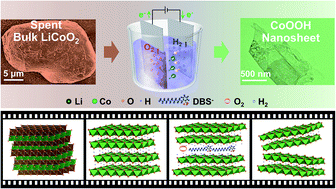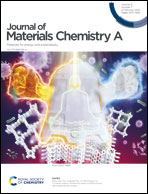Exfoliating spent cathode materials with robust interlayer interactions into atomic-thin nanosheets for boosting the oxygen evolution reaction†
Abstract
Exfoliation of bulk materials is an efficient approach for the fabrication of two-dimensional nanomaterials. However, the application of the method is mostly limited to the delamination of materials with weak interlayer interactions such as van der Waals forces. On the other hand, the massive consumption of layered cathode materials, e.g., LiCoO2, in portable electronic devices highlights the urgent necessity of developing effective strategies to recycle the spent electrode materials. In this work, based on a positive bias driven exfoliation strategy, we report for the first time the synergistic action of phase conversion and lattice expansion that leads to the exfoliation of spent LiCoO2 with robust Li–O interplanar bonding into ultra-thin CoOOH nanosheets, which are well adapted for oxygen evolution reaction (OER) electrocatalysis. This work not only offers a general route to exfoliate layered materials with strong interlayer chemical bonding, but also proposes an effective route to re-utilize the spent electrode materials.



 Please wait while we load your content...
Please wait while we load your content...